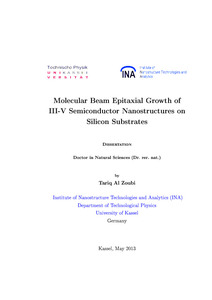| dc.date.accessioned | 2013-07-24T13:51:37Z | |
| dc.date.available | 2013-07-24T13:51:37Z | |
| dc.date.issued | 2013-07-24 | |
| dc.identifier.uri | urn:nbn:de:hebis:34-2013072443092 | |
| dc.identifier.uri | http://hdl.handle.net/123456789/2013072443092 | |
| dc.language.iso | eng | |
| dc.rights | Urheberrechtlich geschützt | |
| dc.rights.uri | https://rightsstatements.org/page/InC/1.0/ | |
| dc.subject | III-V semiconductor | eng |
| dc.subject | Quantum dots | eng |
| dc.subject | Molecular beam epitaxy | eng |
| dc.subject.ddc | 530 | |
| dc.title | Molecular Beam Epitaxial Growth of III-V Semiconductor Nanostructures on Silicon Substrates | eng |
| dc.type | Dissertation | |
| dcterms.abstract | The main focus and concerns of this PhD thesis is the growth of III-V semiconductor nanostructures (Quantum dots (QDs) and quantum dashes) on silicon substrates using molecular beam epitaxy (MBE) technique. The investigation of influence of the major growth parameters on their basic properties (density, geometry, composition, size etc.) and the systematic haracterization of their structural and optical properties are the core of the research work. The monolithic integration of III-V optoelectronic devices with silicon electronic circuits could bring enormous prospect for the existing semiconductor technology. Our challenging approach is to combine the superior passive optical properties of silicon with the superior optical emission properties of III-V material by reducing the amount of III-V materials to the very limit of the active region. Different heteroepitaxial integration approaches have been investigated to overcome the materials issues between III-V and Si. However, this include the self-assembled growth of InAs and InGaAs QDs in silicon and GaAx matrices directly on flat silicon substrate, sitecontrolled growth of (GaAs/In0,15Ga0,85As/GaAs) QDs on pre-patterned Si substrate and the direct growth of GaP on Si using migration enhanced epitaxy (MEE) and MBE growth modes. An efficient ex-situ-buffered HF (BHF) and in-situ surface cleaning sequence based on atomic hydrogen (AH) cleaning at 500 °C combined with thermal oxide desorption within a temperature range of 700-900 °C has been established. The removal of oxide desorption was confirmed by semicircular streaky reflection high energy electron diffraction (RHEED) patterns indicating a 2D smooth surface construction prior to the MBE growth. The evolution of size, density and shape of the QDs are ex-situ characterized by atomic-force microscopy (AFM) and transmission electron microscopy (TEM). The InAs QDs density is strongly increased from 108 to 1011 cm-2 at V/III ratios in the range of 15-35 (beam equivalent pressure values). InAs QD formations are not observed at temperatures of 500 °C and above. Growth experiments on (111) substrates show orientation dependent QD formation behaviour. A significant shape and size transition with elongated InAs quantum dots and dashes has been observed on (111) orientation and at higher Indium-growth rate of 0.3 ML/s. The 2D strain mapping derived from high-resolution TEM of InAs QDs embedded in silicon matrix confirmed semi-coherent and fully relaxed QDs embedded in defectfree silicon matrix. The strain relaxation is released by dislocation loops exclusively localized along the InAs/Si interfaces and partial dislocations with stacking faults inside the InAs clusters. The site controlled growth of aAs/In0,15Ga0,85As/GaAs nanostructures has been demonstrated for the first time with 1 μm spacing and very low nominal deposition thicknesses, directly on pre-patterned Si without the use of SiO2 mask.
Thin planar GaP layer was successfully grown through migration enhanced epitaxy (MEE) to initiate a planar GaP wetting layer at the polar/non-polar interface, which work as a virtual GaP substrate, for the GaP-MBE subsequently growth on the GaP-MEE layer with total thickness of 50 nm. The best root mean square (RMS) roughness value was as good as 1.3 nm. However, these results are highly encouraging for the realization of III-V optical devices on silicon for potential applications. | eng |
| dcterms.accessRights | open access | |
| dcterms.alternative | Wachstum von III-V Halbleiter-Nanostrukturen auf Siliziumsubstraten durch Molekularstrahlepitaxie | ger |
| dcterms.creator | Al Zoubi, Tariq | |
| dc.contributor.corporatename | Kassel, Univ., Fachbereich 10 - Mathematik und Naturwissenschaften | |
| dc.contributor.referee | Reithmaier, Johann Peter (Prof. Dr. ) | |
| dc.contributor.referee | Hillmer, Hartmut (Prof. Dr.) | |
| dc.subject.swd | Molekularstrahlepitaxie | ger |
| dc.subject.swd | Quantenpunkt | ger |
| dc.subject.swd | Nanostruktur | ger |
| dc.date.examination | 2013-07-12 | |

